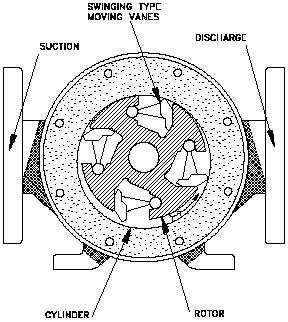POSITIVE DISPLACEMENT PUMPS
DOE-HDBK-1018/1-93
Pumps
Rotary Moving Vane Pump
The rotary moving vane pump shown in Figure 19 is another type of positive displacement
pump used. The pump consists of a cylindrically bored housing with a suction inlet on one
side and a discharge outlet on the other. A cylindrically shaped rotor with a diameter
smaller than the cylinder is driven about an axis placed above the centerline of the cylinder.
The clearance between rotor and cylinder is small at the top but increases at the bottom.
The rotor carries vanes that move in and out as it rotates to maintain sealed spaces between
the rotor and the cylinder wall. The vanes trap liquid or gas on the suction side and carry
it to the discharge side, where contraction of the space expels it through the discharge line.
The vanes may swing on pivots, or they may slide in slots in the rotor.
Figure 19 Rotary Moving Vane Pump
Diaphragm Pumps
Diaphragm pumps are also classified as positive displacement pumps because the diaphragm acts
as a limited displacement piston. The pump will function when a diaphragm is forced into
reciprocating motion by mechanical linkage, compressed air, or fluid from a pulsating, external
source. The pump construction eliminates any contact between the liquid being pumped and the
source of energy. This eliminates the possibility of leakage, which is important when handling
toxic or very expensive liquids. Disadvantages include limited head and capacity range, and the
necessity of check valves in the suction and discharge nozzles. An example of a diaphragm
pump is shown in Figure 20.
ME-03
Rev. 0
Page 26

